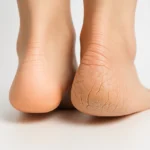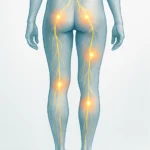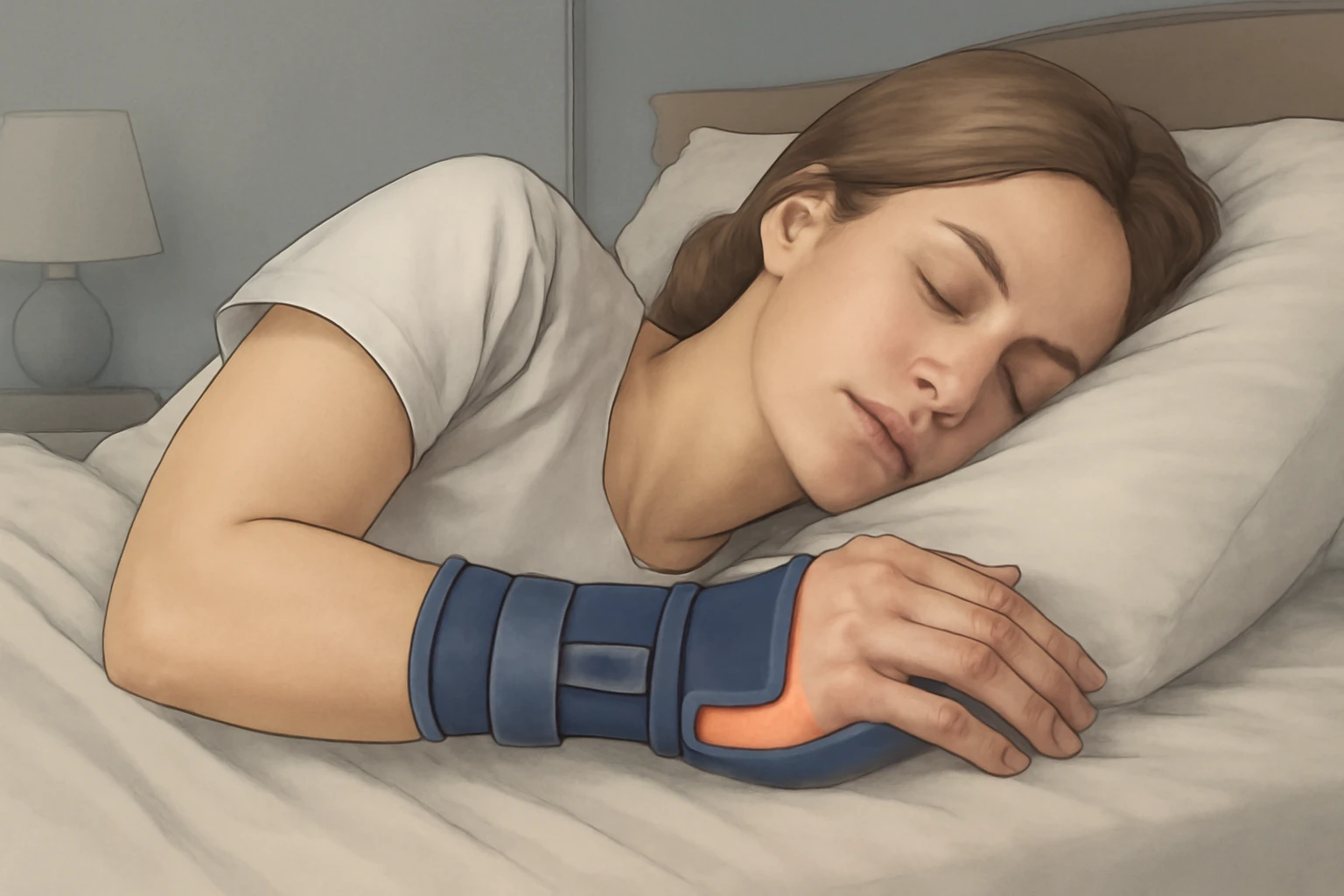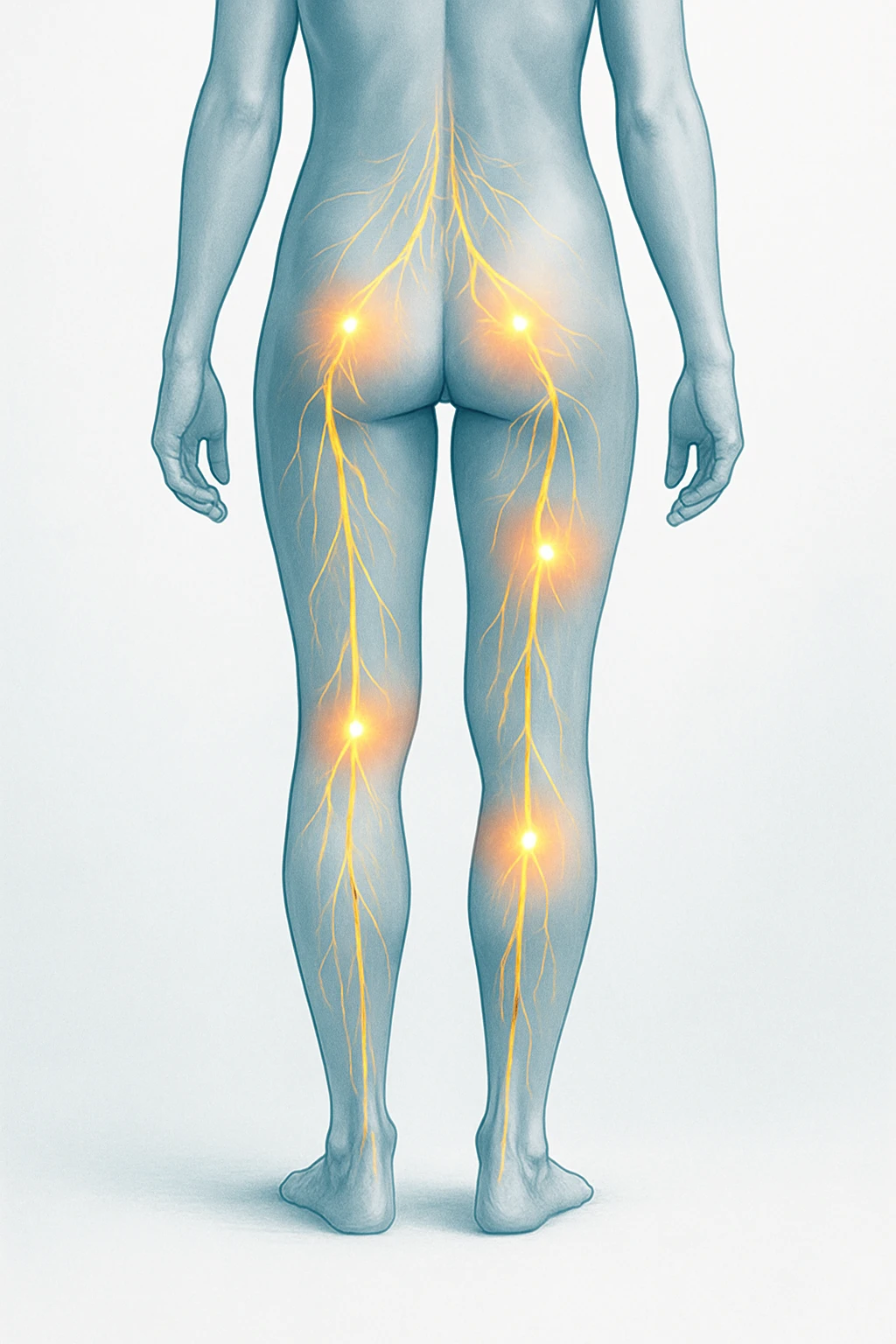
What Causes Numb Hands at Night and How to Treat Them
Nighttime Hand Numbness: Overview and Clinical Importance
Numb hands at night, or nocturnal hand numbness, is a common experience that can range from temporary tingling due to positioning to a sign of underlying nerve involvement. This symptom often arises when pressure or posture interrupts normal nerve signaling in the upper limbs. While occasional episodes are harmless, recurrent or persistent numbness may indicate peripheral nerve compression that warrants medical evaluation.
Clinical Significance
Sleeping with wrists flexed or compressed under body weight can temporarily reduce blood flow and nerve conduction, leading to transient paresthesia. This numbness usually resolves after repositioning. However, frequent or prolonged episodes-especially when accompanied by weakness or pain-suggest a neuropathic cause. The most common underlying issue is median nerve compression in the carpal tunnel, a narrow wrist passage prone to pressure during sleep. This explains why patients often awaken with tingling or a “pins and needles” sensation.
- Temporary numbness: Often caused by wrist or arm positioning during sleep.
- Persistent numbness: May indicate peripheral nerve entrapment, such as carpal tunnel syndrome.
- Associated features: Weakness, pain, or frequent nighttime awakening.
Epidemiologic Context
Nocturnal hand numbness affects many adults, particularly those engaged in repetitive wrist activity or experiencing fluid retention during sleep. Although prevalence varies, it remains one of the most frequent sensory complaints related to peripheral nerve compression. Episodes may disrupt sleep and impair dexterity or grip strength if not addressed. These symptoms typically stem from peripheral rather than central nervous system causes, underscoring the importance of distinguishing benign positional factors from progressive neuropathies.
Mechanisms and Causes of Numb Hands During Sleep
Nerve Compression and Entrapment
The primary cause of numb hands at night involves compression of the peripheral nerves that transmit sensory signals to the hand. The median nerve, passing through the carpal tunnel, is particularly vulnerable during sleep when wrist flexion narrows the tunnel space. This compression disrupts conduction, leading to tingling or numbness that is most pronounced upon waking.
- Median nerve compression: Causes tingling and numbness, often in the thumb, index, and middle fingers.
- Ulnar nerve entrapment: Affects the ring and little fingers due to elbow or wrist pressure.
- Cervical root compression: Originates in the neck and mimics carpal tunnel symptoms but with a different sensory pattern.
Because these patterns may overlap, accurate clinical assessment is required to determine the exact site of compression.
Systemic and Metabolic Causes
Beyond mechanical factors, systemic disorders can contribute to nocturnal paresthesia. Conditions like diabetes and hypothyroidism impair peripheral nerve health through chronic metabolic imbalance, causing reduced nerve sensitivity and delayed transmission. These systemic influences weaken protective nerve structures, increasing susceptibility to compression during sleep. Such cases often produce persistent rather than posture-dependent numbness.
| Condition | Mechanism | Typical Presentation |
|---|---|---|
| Diabetes | Peripheral neuropathy from chronic hyperglycemia | Diffuse, symmetrical numbness; may persist beyond sleep |
| Hypothyroidism | Myxedematous tissue changes causing nerve compression | Generalized numbness, fatigue, or hand swelling |
Postural and Pressure Dynamics
Sleeping posture strongly influences transient hand numbness. Extended wrist or elbow flexion, or resting the head on an arm, can restrict blood flow and compress nerves, leading to a temporary loss of sensation. This usually resolves once the limb is moved. Although generally benign, repetitive compression can worsen existing nerve entrapment or reveal underlying metabolic weakness.
These combined factors-structural, mechanical, and systemic-illustrate how multiple mechanisms interact to cause numb hands at night. Identifying whether symptoms are positional, compressive, or systemic is key to appropriate management.
Risk Factors and Recognizing Clinical Patterns
Key Risk Factors
Several personal and occupational factors raise the likelihood of nocturnal hand numbness, especially in carpal tunnel syndrome. Female sex and pregnancy are linked to hormonal and fluid changes that elevate wrist pressure, while obesity and metabolic disorders such as diabetes increase nerve vulnerability. Repetitive wrist motions from typing or manual work cause chronic strain and reduced tunnel space. During sleep, wrist flexion or elbow bending can further elevate intraneural pressure, triggering numbness episodes.
- Biologic factors: Female sex, pregnancy, and hormonal changes affecting fluid balance.
- Metabolic factors: Obesity and diabetes impacting peripheral nerve health.
- Occupational factors: Repetitive wrist activity or sustained flexion during work or sleep.
Symptom Distribution and Timing
Symptom timing and distribution help clinicians pinpoint the source of numbness. Tingling typically affects the thumb, index, middle, and half of the ring finger-the median nerve region. Symptoms often occur at night or early morning when wrist flexion is most pronounced. Many individuals awaken to shake their hands, temporarily restoring sensation. This nocturnal predominance helps distinguish median nerve entrapment from other causes of hand numbness.
Associated Findings
Besides sensory loss, mild weakness or stiffness may appear on waking, particularly when swelling contributes to nerve pressure. Recurrent nighttime episodes can impair sleep and daily function. Without intervention, prolonged compression may affect fine motor control or grip strength, highlighting the importance of early recognition and treatment.
When to See a Doctor
- Persistent or worsening numbness over time.
- Weakness, pain, or loss of dexterity in the hand.
- Symptoms disrupting sleep or daily activities.
Seek medical evaluation if numb hands at night become persistent, painful, or impair function. Early diagnosis helps distinguish benign positional numbness from progressive neuropathic conditions and prevents chronic nerve injury.
Diagnostic Evaluation and Testing
Clinical Evaluation
The diagnostic process for nocturnal hand numbness begins with a detailed history and physical examination focused on sensory distribution, timing, and related symptoms. Numbness in the thumb, index, middle, and half of the ring finger suggests median nerve compression, while involvement of the little finger points to ulnar pathology. Assessing whether symptoms occur solely during sleep or persist during the day helps distinguish positional compression from chronic neuropathy.
- Median nerve involvement: Numbness in the thumb, index, middle, and half of the ring finger.
- Ulnar nerve involvement: Numbness primarily in the little finger.
- Timing patterns: Nighttime-only symptoms suggest positional causes; persistent symptoms suggest neuropathy.
Physical examination includes provocative maneuvers to reproduce or localize symptoms, such as wrist flexion, extension, or gentle percussion over nerve pathways. Strength and grip testing complement sensory mapping, narrowing the differential diagnosis before confirmatory studies.
Confirmatory Testing
Electrodiagnostic studies are the cornerstone of confirming nerve entrapment. Nerve conduction studies measure electrical signal speed and amplitude, detecting slowed transmission at compression sites. Electromyography (EMG) evaluates muscle response to nerve input, distinguishing localized entrapment from systemic neuropathies. Together, these tests objectively define the severity and extent of dysfunction.
| Test Type | Purpose | Findings |
|---|---|---|
| Nerve Conduction Study | Measures speed and amplitude of nerve signals | Identifies slowed conduction at compression sites |
| Electromyography (EMG) | Evaluates muscle response to stimulation | Shows muscle denervation or chronic nerve injury |
| Ultrasound | Visualizes nerve swelling or compression | Reveals thickening or soft-tissue abnormalities |
| MRI | Assesses deep structures and surrounding tissues | Detects edema or mass effect |
When structural abnormalities are suspected, imaging supports diagnosis. Ultrasound visualizes nerve swelling and compression points, while MRI reveals deeper causes such as tendon sheath thickening or edema. Combining clinical findings with diagnostic tests ensures accurate evaluation and guides targeted management.
Treatment and Prevention of Numb Hands at Night
Conservative Management
Initial management of numb hands at night focuses on reducing nerve compression and alleviating symptoms through non-invasive approaches. Nighttime wrist splinting in a neutral position is one of the most effective strategies for decreasing pressure within the carpal tunnel, particularly in cases involving the median nerve. Maintaining this neutral posture helps prevent flexion or extension that could worsen compression during sleep. Addressing systemic contributors such as diabetes and hypothyroidism is equally important, as optimizing these conditions supports overall nerve health and responsiveness.
- Wrist splinting: Keeps the wrist in a neutral position to relieve pressure on the median nerve.
- Systemic condition management: Optimizing diabetes or thyroid disorders supports nerve function.
- Ergonomic adjustments: Proper workstation setup and posture reduce repetitive strain.
Ergonomic correction in daily activities is central to conservative care. Adjusting workstation height, keyboard position, and hand alignment minimizes repetitive wrist strain. Incorporating rest breaks and maintaining neutral wrist alignment during tasks help reduce cumulative nerve irritation and promote recovery over time.
Medical and Surgical Interventions
When conservative strategies fail to relieve symptoms or when significant nerve dysfunction is suspected, medical or surgical interventions may be warranted. Corticosteroid injections can temporarily decrease inflammation and edema within the carpal tunnel, improving nerve conduction and symptom relief. However, these treatments are generally reserved for cases where splinting and ergonomic modifications have proven insufficient.
| Approach | Mechanism | Clinical Goal |
|---|---|---|
| Corticosteroid Injection | Reduces inflammation and edema within the carpal tunnel. | Provides temporary symptom relief and improved nerve conduction. |
| Surgical Decompression | Releases the transverse carpal ligament to relieve median nerve pressure. | Offers definitive relief for severe or persistent cases, preventing progression of nerve damage. |
For chronic or severe cases, surgical decompression of the affected nerve provides a long-term solution. In carpal tunnel syndrome, this procedure involves releasing the transverse carpal ligament to reduce median nerve pressure. Outcomes are typically favorable, especially when performed before irreversible nerve injury develops. Postoperative rehabilitation and ergonomic reassessment support recovery and long-term function.
Preventive Strategies
Preventing numb hands at night relies on maintaining proper wrist and arm positioning during rest and activity. Keeping wrists in a neutral position during sleep prevents flexion-related compression, and supportive splints can provide added stability. Awareness of sleeping posture-avoiding prolonged elbow bending or pressure on the arms-further reduces recurrence risk.
- Maintain neutral wrist alignment while sleeping or typing.
- Avoid resting arms under the head or body during sleep.
- Incorporate microbreaks and hand stretches during repetitive work.
- Adjust desk and chair height to minimize wrist strain.
Frequently Asked Questions about Numb Hands at Night
- What causes numb hands at night? Numb hands at night are commonly caused by nerve compression, such as carpal tunnel syndrome, or by poor wrist positioning during sleep.
- Is numbness in my hands a sign of a serious condition? While temporary numbness is often harmless, persistent or recurrent numbness may indicate nerve compression or systemic issues like diabetes or hypothyroidism.
- How can I prevent numb hands at night? Preventative measures include adjusting sleep posture, using wrist splints, and managing underlying conditions like obesity, pregnancy, or diabetes.
- When should I see a doctor for numb hands? Consult a doctor if numbness persists, worsens over time, or causes weakness, pain, or impaired function, especially if it disrupts sleep.
- What tests help diagnose numb hands at night? Nerve conduction studies and electromyography (EMG) are used to confirm nerve entrapment, while ultrasound and MRI may identify structural issues.
- Can wrist splints really help with numb hands at night? Yes, wearing a wrist splint in a neutral position can reduce pressure on the median nerve, providing relief from numbness and preventing further damage.
- Are there any lifestyle changes that can help with numb hands at night? Ergonomic adjustments at work, regular breaks, and maintaining proper wrist alignment during sleep or typing can reduce the risk of numb hands at night.
- How do I know if it’s carpal tunnel syndrome? Carpal tunnel syndrome typically causes numbness in the thumb, index, middle, and half of the ring finger, especially at night or upon waking.




















